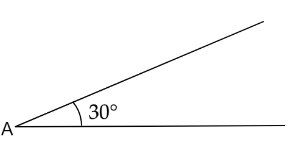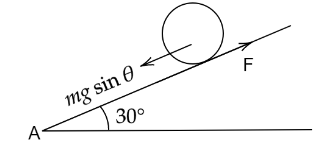
A solid sphere of mass 2 $kg$ radius 0.5$m$ is rolling with an initial speed of 1 $m{s^{ - 1}}$ goes up an inclined plane which makes an angle of ${30^ \circ }$ with the horizontal plane, without slipping. How long will the sphere take to return to the starting point A?

1. $0.80$ sec
2. $0.60$ sec
3. $0.52$ sec
4. $0.57$ sec
Answer
221.4k+ views
Hint: In this question, we are given a solid sphere which is rolling with an initial speed 1 $m{s^{ - 1}}$ goes up an inclined plane and make ${30^ \circ }$ angle with the horizontal plane. We have to find the total time taken by the sphere to go up and return. First step is to equate the force to find the acceleration. Then, apply the formula \[Time{\text{ }}taken = \dfrac{{velocity}}{{acceleration}}\] to calculate the time. Also, while calculating the time double the velocity as it is same in time of ascent and decent
Formula used:
Moment of inertia (solid sphere) $I = \dfrac{2}{5}m{r^2}$
Formula of time in terms of velocity and acceleration –
\[Time{\text{ }}taken = \dfrac{{velocity}}{{acceleration}}\]
Complete answer:
Given that,
Mass of the solid sphere, $m = 2kg$
Radius of the sphere, $r = 0.5m$
Initial speed of the sphere, $u = 1m{s^{ - 1}}$
Angle of inclination $ = {30^ \circ }$

Now, the force of the solid sphere going upward is $F = \dfrac{{mg\sin \theta }}{{1 + \dfrac{I}{{m{r^2}}}}}$
Moment of inertia of the solid sphere is $I = \dfrac{2}{5}m{r^2}$
It implies that,
$ma = \dfrac{{mg\sin \theta }}{{1 + \dfrac{{\left( {\dfrac{2}{5}m{r^2}} \right)}}{{m{r^2}}}}}$
$a = \dfrac{{g\sin {{30}^ \circ }}}{{\left( {1 + \dfrac{2}{5}} \right)}}$
Here, acceleration of gravity $g = 9.8m{s^{ - 2}}$
$a = \dfrac{5}{7} \times \dfrac{{9.8}}{2}$
$a = 3.5m{s^2}$
As we know that,
\[Time{\text{ }}taken = \dfrac{{velocity}}{{acceleration}}\]
Due to symmetry time of ascent and decent will be same. Therefore, initial velocity will be double,
\[t = \dfrac{{2u}}{a}\]
\[t = \dfrac{{2\left( 1 \right)}}{{\left( {3.5} \right)}}\]
$t = 0.57$ sec
Hence, Option (4) is the correct answer i.e., $0.57$ sec.
Note: The key concept involved in solving this problem is the good knowledge of moment of inertia. Students must remember that in physics, a moment of inertia is a quantitative measure of a body's rotational inertia—that is, the resistance that the body exhibits to having its speed of rotation about an axis altered by the application of a torque (turning force). The axis can be internal or external, and it can be fixed or not.
Formula used:
Moment of inertia (solid sphere) $I = \dfrac{2}{5}m{r^2}$
Formula of time in terms of velocity and acceleration –
\[Time{\text{ }}taken = \dfrac{{velocity}}{{acceleration}}\]
Complete answer:
Given that,
Mass of the solid sphere, $m = 2kg$
Radius of the sphere, $r = 0.5m$
Initial speed of the sphere, $u = 1m{s^{ - 1}}$
Angle of inclination $ = {30^ \circ }$

Now, the force of the solid sphere going upward is $F = \dfrac{{mg\sin \theta }}{{1 + \dfrac{I}{{m{r^2}}}}}$
Moment of inertia of the solid sphere is $I = \dfrac{2}{5}m{r^2}$
It implies that,
$ma = \dfrac{{mg\sin \theta }}{{1 + \dfrac{{\left( {\dfrac{2}{5}m{r^2}} \right)}}{{m{r^2}}}}}$
$a = \dfrac{{g\sin {{30}^ \circ }}}{{\left( {1 + \dfrac{2}{5}} \right)}}$
Here, acceleration of gravity $g = 9.8m{s^{ - 2}}$
$a = \dfrac{5}{7} \times \dfrac{{9.8}}{2}$
$a = 3.5m{s^2}$
As we know that,
\[Time{\text{ }}taken = \dfrac{{velocity}}{{acceleration}}\]
Due to symmetry time of ascent and decent will be same. Therefore, initial velocity will be double,
\[t = \dfrac{{2u}}{a}\]
\[t = \dfrac{{2\left( 1 \right)}}{{\left( {3.5} \right)}}\]
$t = 0.57$ sec
Hence, Option (4) is the correct answer i.e., $0.57$ sec.
Note: The key concept involved in solving this problem is the good knowledge of moment of inertia. Students must remember that in physics, a moment of inertia is a quantitative measure of a body's rotational inertia—that is, the resistance that the body exhibits to having its speed of rotation about an axis altered by the application of a torque (turning force). The axis can be internal or external, and it can be fixed or not.
Recently Updated Pages
Uniform Acceleration Explained: Formula, Examples & Graphs

JEE Main 2022 (July 26th Shift 1) Physics Question Paper with Answer Key

JEE Main 2022 (June 26th Shift 2) Chemistry Question Paper with Answer Key

Apparent Frequency Explained: Formula, Uses & Examples

JEE Main 2023 (January 30th Shift 2) Chemistry Question Paper with Answer Key

JEE Main 2023 (April 15th Shift 1) Physics Question Paper with Answer Key

Trending doubts
JEE Main 2026: Application Form Open, Exam Dates, Syllabus, Eligibility & Question Papers

Derivation of Equation of Trajectory Explained for Students

Hybridisation in Chemistry – Concept, Types & Applications

Understanding the Angle of Deviation in a Prism

How to Convert a Galvanometer into an Ammeter or Voltmeter

Degree of Dissociation: Meaning, Formula, Calculation & Uses

Other Pages
Thermodynamics Class 11 Physics Chapter 11 CBSE Notes - 2025-26

JEE Advanced Marks vs Ranks 2025: Understanding Category-wise Qualifying Marks and Previous Year Cut-offs

Units And Measurements Class 11 Physics Chapter 1 CBSE Notes - 2025-26

NCERT Solutions For Class 11 Physics Chapter 8 Mechanical Properties Of Solids

Motion in a Straight Line Class 11 Physics Chapter 2 CBSE Notes - 2025-26

Laws of Motion Class 11 Physics Chapter 4 CBSE Notes - 2025-26




